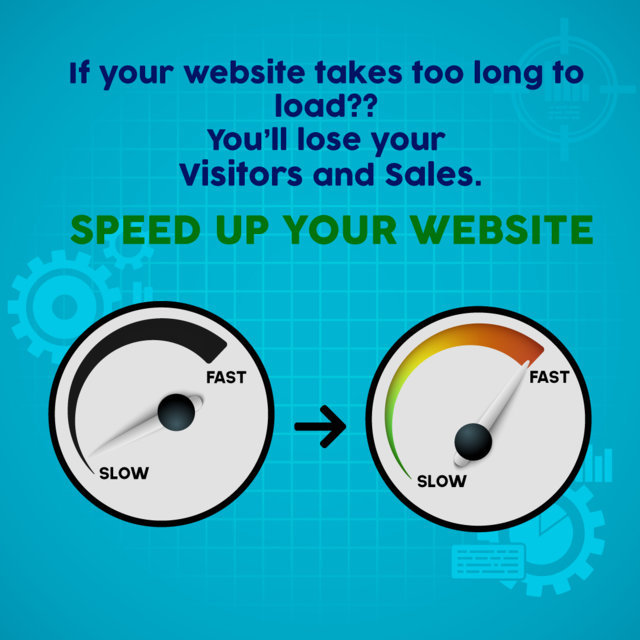How to improve your website Speed?
Creating a fantastic site takes good work. Leading online companies leverage industry-proven expertise, supernatural internet development skills,  and also a killer internet hosting agency to come up with sites boasting top-notch performance amounts and consumer expertise. However, for people who miss this beginning point in their own pursuit of speed-optimized sites, using a slick approach in executing easy DIY page rate optimization strategies works (nearly ) well enough to spot slow sites.
and also a killer internet hosting agency to come up with sites boasting top-notch performance amounts and consumer expertise. However, for people who miss this beginning point in their own pursuit of speed-optimized sites, using a slick approach in executing easy DIY page rate optimization strategies works (nearly ) well enough to spot slow sites.
The understanding of investing in the ideal set of site velocity optimization solutions and solutions, site management, and possibly downright coding trickery is imperative to yield maximum site performance. Strategic business decisions based on this understanding contribute directly toward improving website performance that consequently, result in better internet sales leads, conversions, and finally business success.
Optimization is the buzzword of succeeding in the cyber world. Cyberspace, such as the true physical universe of planets, stars, and galaxies is in flux — a condition of constant change and development. In reality, change is the only consistent process across the actual and the cyber world. Survival in these types of spaces is dependent upon how well the people could adapt to varying environmental and resource conditions.
And the same holds for site owners competing for internet business success amid changing market tendencies, altering the behavior of net visitors, progress in cyber technology at breakneck rates under Moore’s Law, and varying site performance criteria set forth by research engine giants.

DIY (Do It Yourself) Speed Optimization:
Internet small business owners and owners adapt their sites to keep optimum results under constant change from improvising and optimizing crucial components of site design that make or break page rate.
Image Optimization:
As a general guideline, larger files take longer to obtain than smaller documents. Web page download time, also called the Page Load Time is determined by the entire size of content resources being downloaded in hosting servers to the requesting browser. High-quality bulky pictures are the biggest contributors to internet page dimensions, degrading page rate, and agitating traffic eagerly awaiting the web page to load.
Based on HTTP Archive, in December 2017, pictures constitute on average 66 percent of an entire page’s weight. The next picture optimization best-practices go a long way in reducing the adverse Effect of pictures on site speed:
Format Choice: Utilize JPGs when quality is a top priority and picture alterations aren’t needed before uploading it. JPGs can take restricted processing and alterations before picture quality degrades sharply. For pictures with logos, icons, illustrations, hints, and text, use PNG format. Use GIFs just for simple or small graphics and prevent BMPs or TIFFs. Utilize browser resizing abilities to create pictures responsive by placing fixed width and auto-height directions. For retina displays, raise (JPGs) picture size by 150-200 percentage, compress by 30-40 percent and scale down it according to the necessary measurements.
Fewer Pictures: Maintain the Number of pictures to an absolute minimum.
WordPress Optimzation:
Leverage picture optimization plugins like Imagify, ShortPixel Picture Optimizer, Optimus WordPress Picture Optimizer, WP Smush, TinyPNG, EWWW Picture Optimizer Cloud. It is better if you choose those which compress and optimize pictures, which lowers the load on your site and you can speed up the website.
And for more information check out our comprehensive picture optimization guide.
CSS Optimization:
Not too long ago, 30 KB was regarded to be the perfect web page dimensions. And that included pictures, graphics, content, and code creating the whole page. The prevalence of both CSS and JavaScript tore apart the ceiling of 30 KB page size in providing an enriched site user experience.
However, modern sites coded in CSS are far better at downloading articles from hosting servers into asking browsers economically and correctly. Optimization, consequently, is not about minifying file dimensions.

Shorthand Coding: Cut down the size of your code by simply utilizing fewer declarations and operators. Fewer lines of code mean fewer processing cycles and effective delivery of site files to asking browsers.
Axe Browser Specific CSS Hacks: CSS is at risk from endlessly complex browser certain hacks — or correctional declarations as they’re called — including unnecessary burden to CSS script documents. Speed-optimized CSS code is equally mild and easy for servers to process effectively.
Minify CSS: just about all site speed tracking tools provide a frequent suggestion of reducing the burden of CSS code to enhance speed. Lightweight and streamlined code will help to accelerate downloading, parsing and implementation to dramatically reduce page loading time.
Code Positioning: Load CSS code in the and JavaScript within your system, as copying CSS out of the segment prevents Web browsers from showing CSS content instantly after downloading it.
CSS Delivery Best Practices:
- Don’t utilize @import call.
- Don’t use CSS in HTML for example H1 and DIV tags.
- Utilize inline little CSS.
WordPress Plugins for Website speed optimization:
Tools like Autoptimize, WP Rocket, Cache Enabler, Cloudflare CDN, and W3 Full Cache are a Few of the most Well-known tools available for minifying JavaScript and CSS. You can speed up the website by using one of these plugins.
Minification Java Script |HTML |Css:
Really, speed optimization is not (only ) about diminishing page dimensions. Lowering the number of client-server asks in providing blog content to Internet browsers is an essential component of website engine optimization. Even though the amount of requests is not as significant as it used to be due to improvements using HTTP/2.
Minification is very essential for inline JavaScript and external documents not cached. Google recommends minifying all JavaScript documents over 4096 bytes of dimensions, along with shaving a minimum of 25 bytes to create any noticeable gap toward webpage loading time.

A strict approach toward designing rate-optimized sites could incorporate a powerful intent to remove unnecessary bytes in the code. Using all of the programming space accessible, deleting additional spaces, indentation, and line spaces while preserving readability of the code lowers the total size of site core and front-end documents. And for sites currently developed with this particular strategy in view, mixing multiple server requests (such as HTML, JavaScript, and CSS) into single ones efficiently slashes large chunks from page loading times.
But, overindulgence at HTML Minification possibly contributes to lack of fidelity of the site code, together with consumer representatives taking excess memory cycles and CPU power in”imagining” the lost tools necessary to parse HTML documents. Tracking page loading functionality varies in reaction to implementing every minification process individually guarantee that just the unnecessary spaces and code are deleted.
Minification of CSS, JavaScript, and HTML share common advantages: reduced network latency, fewer HTML asks, increased compression, faster browser downloading and implementation, finally fostering page speed and affording higher scores on-site speed measuring instruments.
Database Optimization:
WordPress CMS shops posts, opinions, pages, and other kinds of encoded and textual data inside one database — except for videos and images which are stored at the’wp_content’ folder instead. This database becomes packed over time, but not just with unnecessary articles and article revisions, but with garbage information.
Database optimization revolves around eliminating garbage useless and data articles from databases that are cluttered, decreasing them in dimension, and making it simpler for hosting servers to bring requested content effectively, within minimal processing cycles. Additionally, this may involve ensuring that you’re using InnoDB to your MySQL database tables, instead of MyISAM.
The wp_options table can be frequently overlooked in regards to overall WordPress and database functionality. Especially on elderly and massive websites, this is sometimes the culprit for slow query occasions on your website as a result of autoloaded data that’s left from third-party plugins and topics. Have a look at our guide on the way best to clean up your wp_options dining table.
Compression :
Based on Google, daily that the cyber world finds 99 decades old squandered as a result of uncompressed Internet content. And although the majority of the most recent Web browsers encourage content compression capacities, not every site delivers compressed content. Visitors to those bandwidth-hogging sites experience insanely slow connections with Web pages.Uncompressed content strikes bandwidth-constrained users getting the internet content in an agonizingly long page loading times.
Cache:
Developers crave simplicity in site design code. Site code simpler to produce, read and keep contributes to efficient site develo

pment procedures. Including using the accessible code works often to reduce brief extensive coding for certain site performance.
However, adding a lot of extraneous loops and unnecessary code traces raises page rendering times by some milliseconds. Influx a torrent of traffic, and also the milliseconds chemical to dip page rank well below acceptable criteria.
Advertisers may lessen these reaction times by providing cached copies of the content that is requested rather than making it in response to every user request that pings their host. This procedure lowers the number of round trips taken in providing (static) site content to asking browsers.
All of these were recommended to help build a faster site except? “Server Error”. Due to server Error, the speed of the site cannot be increased. User experience depends on the loading page, if the loading page time is less than 3 seconds then the user will be satisfied with the speed of the site. Page load speed is the time it takes for the page to load and it can affect your user experience too. For fast loading, use optimized images and try to avoid extra widgets.
 Global Elix
Global Elix 